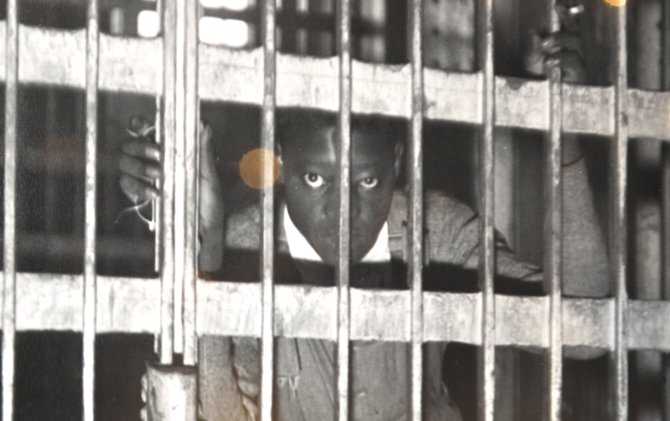Haywood Patterson and two other members of the Scottsboro Boys, who were falsely accused of raping two white women in 1931, recently received posthumous pardons. A photo exhibit of Patterson's trial is on display at Jackson State University. Photo by Trip Burns.
For his alleged participation in raping two white women, prosecutors apparently wanted 17-year-old Haywood Patterson to stand trial first "because he has the blackest skin, the wickedest gleam in his eyes, and the meanest expression on his face," wrote Carleton Beals in The Nation magazine, in the winter of 1936.
In 1931, Patterson was one of nine young black men to face several juries in the town of Scottsboro, Ala., when two white women accused them of rape for reasons that remain largely unknown.
Each of the Scottsboro Boys served prison time. Five of the boys—Olen Montgomery, Ozie Powell, Willie Roberson, Eugene Williams and Roy Wright—had their convictions overturned in 1937. The judge sentenced another, Clarence Norris, to death, but he escaped and went into hiding. Then-Gov. George Wallace pardoned Norris in 1976 ; he died in 1989.
Last week, Patterson and two other members of the group received the closest thing to justice possible in the form of a pardon from the Alabama Parole Board after the state's Legislature passed legislation earlier in the year making the posthumous pardons possible.
"Does it change history? Of course it doesn't," Alabama Sen. Arthur Orr, R-Decatur, who sponsored the bill, told media when the legislation passed.
Richard Cohen, president of the Montgomery, Ala.-based Southern Poverty Law Center, which lobbied for the legislation, said the trial echoes similar injustices today.
"Today, are criminal defendants always provided with effective assistance of counsel? Today, are our juries chosen free of racial discrimination? ... Until we can answer 'yes' to both of those questions, the shadow of the Scottsboro Boys will continue to linger," Cohen said during a news conference at the Alabama statehouse in early 2013.
Fred Hiroshige, a Decatur photographer, took pictures during Patterson's trial that are now on display at Jackson State University's Johnson Hall Art Museum. The exhibit, which features approximately 30 photos of the Scottsboro Boys as well as their accusers (Victoria Price and Ruby Bates), jurors, attorneys and reporters debuted Nov. 11 with a reception at JSU.
Linda Beito, a criminal justice professor at Stillman College in Tuscaloosa who has researched the Scottsboro case, called the events an example of "racism at its worst" that contemporaries would have difficulty comprehending.
"We cannot compare (the racism of) now to 1931. Just as 1931 couldn't imagine the totality of slavery, there's no way we could imagine how bad it was in 1931," Beito said.
The photo exhibit, "The Scottsboro Boys: Outside the Protective Circle of Humanity" will be on display from Nov. 11 to Dec. 13 in the Johnson Hall Art Gallery at Jackson State University.




Comments